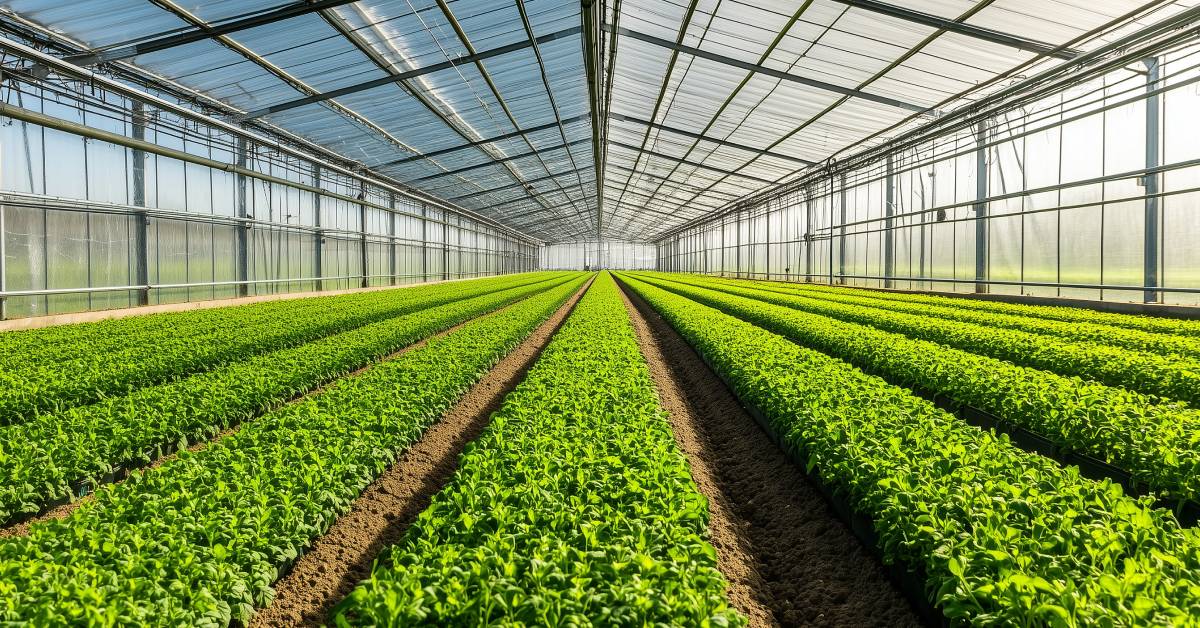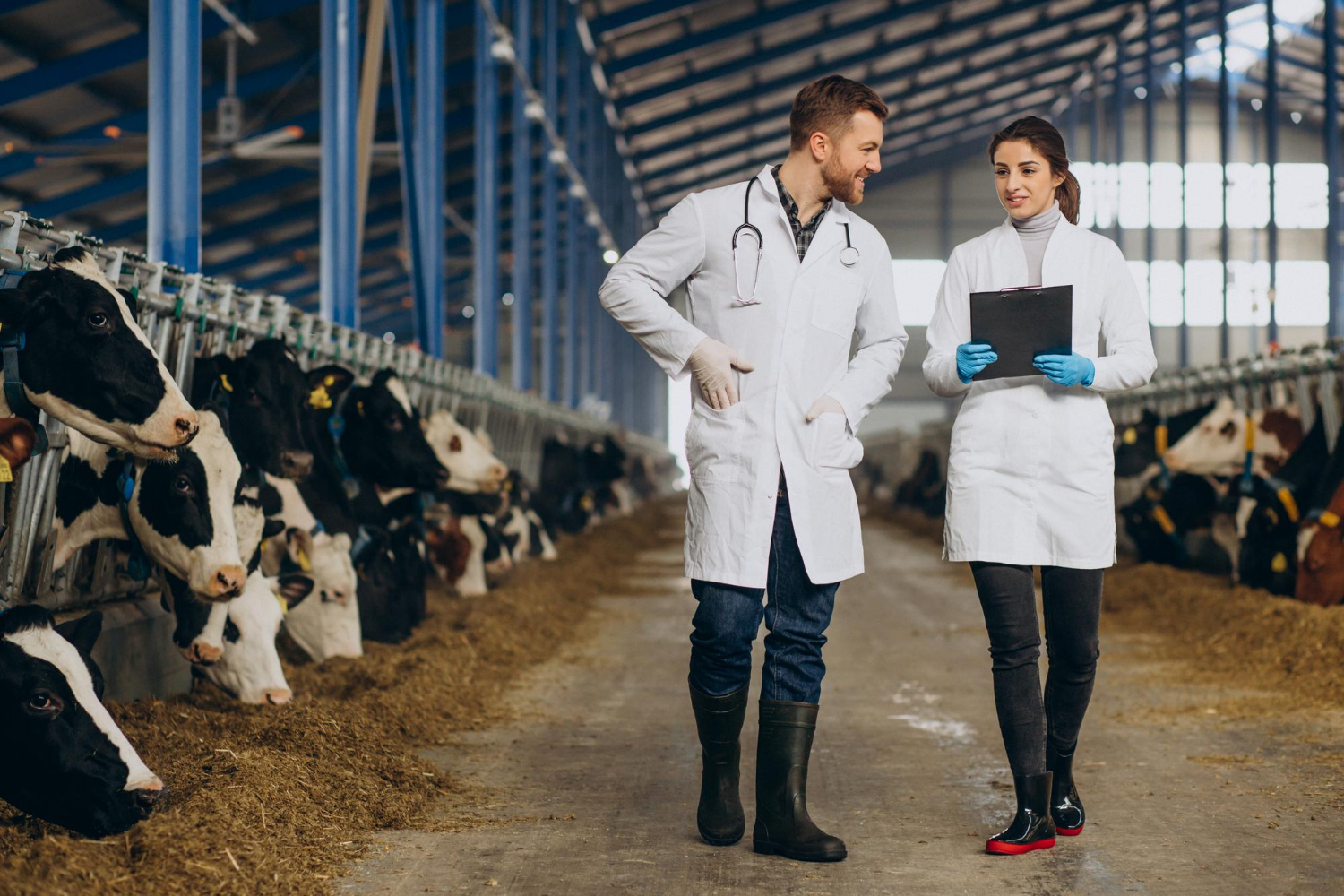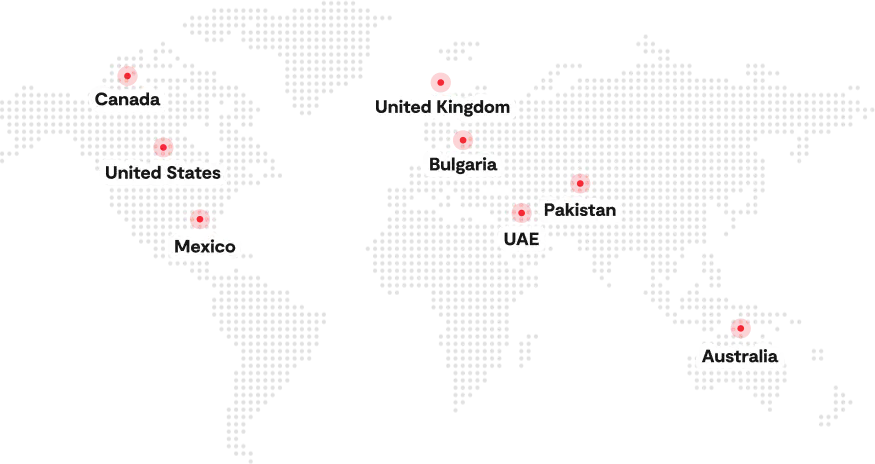Growing food indoors, where you can actually manage everything from air flow to how much CO₂ plants get, is a major advancement in modern agriculture. Instead of relying on outside weather, which can be unpredictable, farmers can now give crops exactly what they need, every time.
With this kind of setup, growers gain more control over quality and output. Controlled environment agriculture today is being used in all kinds of places like high-tech greenhouses, vertical farms, and even urban buildings. According to Custom Market Insights, the controlled environment agriculture market is projected to reach USD 1.22 trillion in 2025, expanding from USD 1.10 trillion in 2024, with a compound annual growth rate of 11.4% through 2034. This rapid growth signals a major shift in how global agriculture is evolving to meet future challenges.
It’s not just lettuce and herbs either. Farmers are growing tomatoes, strawberries, and some pretty specific niche crops too. The point is, this method helps reduce land use, keeps waste lower, and supports the push to grow food closer to where people live.
In this blog, we’ll talk more about how controlled environment agriculture works, what it includes, how it connects to CEA greenhouses, how technology can enhance these systems, and why this might be the future of farming altogether.
What Is Controlled Environment Agriculture (CEA)?
Controlled environment agriculture isn’t the usual way of growing food. Instead of farming outdoors, where weather and pests are always a factor, this method happens indoors, in places like greenhouses or vertical farms. Everything is managed from the inside out. The grower has control over the climate, the lighting, and even things like air flow. This setup means the plants aren’t at the mercy of bad soil or unexpected conditions. It’s all designed to help crops grow better, faster, and with fewer risks. The types of controlled environment agriculture include:
- Greenhouses: Structures that use transparent walls and roofs to allow sunlight while retaining heat, allowing for control over temperature, humidity, and light.
- Vertical Farms: These systems stack crops vertically, often using hydroponic or aeroponic systems to deliver nutrients.
- Indoor Grow Rooms: Enclosed areas with artificial lighting, temperature control, and precise irrigation systems, allowing for year-round production regardless of climate.
CEA farming uses iot sensors, automation systems, and data analytics to manage key variables like:
- Temperature
- Humidity
- Carbon dioxide levels
- Nutrient delivery
- Light exposure
- Environmental zone mapping
- Multi-variable climate control setups
By monitoring and adjusting these factors in real time, farmers with the help of this data ensure maximum crop quality and yield throughout the year. This method is particularly valuable in urban or resource-scarce areas, where traditional agriculture may be impossible
Controlled environment agriculture is also scalable. Whether it’s a single container farm in a city or a vast commercial greenhouse setup, CEA agriculture is adaptable to different sizes and locations. It supports sustainable agriculture practices such as hydroponics, aquaponics, and aeroponics, using significantly less water and land compared to conventional methods.
In short, controlled environment agriculture enables year-round, high-efficiency farming in any climate or geography. It turns farming into a predictable, data-driven science.
Key Components of Controlled Environment Agriculture
To understand controlled environment agriculture, it’s important to look at its core elements. These work together to create and maintain the ideal growing conditions for crops.
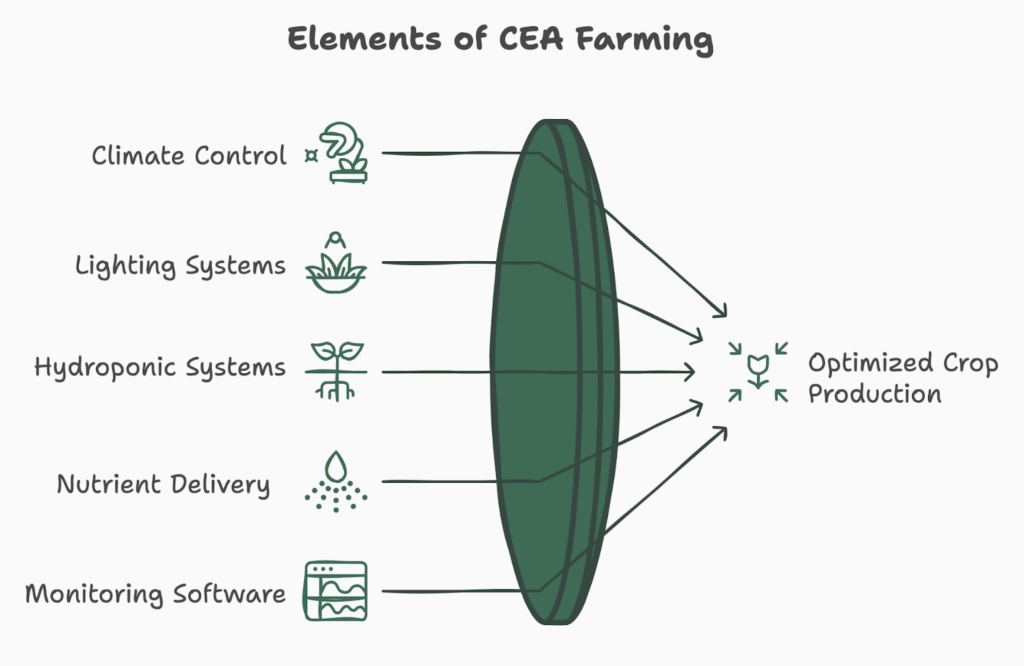
1. Enclosed Growing Structures
CEA farming typically happens inside greenhouses, shipping containers, or vertical farm towers. These structures isolate the crops from external factors, making it easier to control internal conditions.
2. Lighting Systems
LED grow lights are a key feature in many controlled environment agriculture setups. They provide the specific light spectrum plants need for photosynthesis, especially in indoor environments without natural sunlight.
3. HVAC and Climate Controls
HVAC systems (Heating, ventilation, and air conditioning systems) keep the greenhouse environment stable. They regulate humidity and temperature for crop growth and help manage airflow and CO2 enrichment.
4. Hydroponics and Nutrient Delivery
Many CEA farms use hydroponic systems, where plants grow in water infused with nutrients instead of soil. Automated systems track and adjust nutrient levels, ensuring plants get exactly what they need. Instead of soil, many CEA operations rely on water-based systems to deliver nutrients.
- Hydroponics: Plants are grown with roots submerged in a nutrient-rich water solution.
- Aeroponics: Roots are suspended in air and misted with nutrients.
- Aquaponics: Combines hydroponics with fish farming, using fish waste as plant fertilizer.
5. Sensor Networks and Data Analytics
Sensors track temperature, moisture, pH, and light levels. This data feeds into analytics software, helping farmers make decisions based on real-time conditions. Predictive models can even forecast plant growth rates or potential disease outbreaks.
6. Automation and Robotics
From seeding and transplanting to harvesting, robotics in agriculture increase efficiency and reduce labor dependency. Some farms use robotic arms, conveyor belts, or drones to carry out routine tasks.
Each component contributes to the larger goal: a highly efficient, replicable system that minimizes resource use while maximizing yield.
Benefits of Controlled Environment Agriculture
Controlled environment agriculture brings a modern, resource-efficient approach to growing food. It offers increased control over every variable, which leads to more predictable outcomes and better crop quality. This approach is especially relevant today as climate uncertainty, land shortages, and population growth challenge traditional farming.
The following are a few of the key benefits:
1. Year-Round Production
Because it is unaffected by weather and seasons, CEA farming ensures consistent harvests throughout the year. This improves supply chain reliability and reduces price fluctuations.
2. Space Efficiency
CEA greenhouse systems can grow more food in less space. Vertical farms, for example, can stack multiple layers of crops in a single building.
3. Water Conservation
Hydroponic and aeroponic systems use up to 90% less water than traditional field farming. Recirculated aquaculture systems further minimize waste.
4. Reduced Pesticide Use
With enclosed spaces and strict monitoring, the need for chemical pesticides drops significantly. This results in cleaner, safer produce.
5. Proximity to Urban Centers
CEA agriculture can be established close to cities, reducing transportation costs and emissions. Fresher produce reaches consumers faster.
6. Consistent Quality
With precise control over growing conditions, farmers can maintain uniform crop size, taste, and nutrition.
7. Resilience to Climate Change
Since it is independent of external weather conditions, controlled environment agriculture is less affected by droughts, floods, or temperature extremes.
These benefits collectively contribute to a more secure and sustainable global food system.
Applications and Use Cases of CEA Agriculture
Controlled environment agriculture is not limited to leafy greens or microgreens. It encompasses a wide range of applications that stretch across crop types, regions, and commercial models. From vertical farms in urban centers to high-tech greenhouses in rural areas, CEA agriculture has proven adaptable and scalable. Let’s explore a few use cases where CEA agriculture is being used:
Urban Farming
CEA farming enables food production in urban environments, often in repurposed warehouses or shipping containers. This shortens the farm-to-table supply chain.
Desert and Arid Regions
In places with limited arable land or water, controlled environment agriculture makes it possible to grow food sustainably. Countries in the Middle East and North Africa are investing heavily in these technologies.
Research and Seed Production
Controlled setups are ideal for developing new crop varieties, seed trials, and academic research. They allow for consistency and repeatability in experimentation.
Pharmaceutical and Functional Crops
CEA agriculture can produce plants for pharmaceutical or nutraceutical use, such as cannabis or herbal medicine, where purity and consistency are vital. In these cases, businesses must also navigate specific financial challenges, including the need for cannabis merchant accounts to handle transactions securely and in compliance with regulations.
Food Security and Disaster Relief
Portable vertical farms and container-based systems can provide food in refugee camps, disaster zones, or during food supply chain disruptions.
The diversity of use cases shows that controlled environment agriculture is not a niche solution. It’s a global strategy to meet evolving food challenges.
CEA Farming and Greenhouse Environment Systems
Greenhouse farming plays a foundational role in controlled environment agriculture. They are among the most widely used structures in CEA farming, combining natural light with artificial enhancements to create an optimal growing environment.
A modern CEA greenhouse is more than just a glass building. It’s an integrated system where light, temperature, humidity, and air circulation are precisely managed. Environmental sensors collect data, and automated controls adjust fans, vents, heaters, and lighting accordingly. Some greenhouses are semi-closed, using a combination of natural ventilation and mechanical systems. Others are fully enclosed with total climate control, ideal for profitable crops like leafy greens or herbs.
CEA greenhouse systems are often designed to accommodate hydroponic growing beds, like drip irrigation, and automated harvesting tracks are a major part. They are built to maintain stable crop irrigation systems while protecting crops from pests and diseases.
Additionally, the greenhouse environment is highly customizable. For example, growers can simulate different seasons or daylight hours to optimize the growth cycle of specific plants. Innovations like dynamic shading, infrared reflectors, and energy-efficient insulation materials are now being used to further reduce energy consumption in CEA greenhouses.
Greenhouses used in controlled environment agriculture offer the perfect balance between control and scalability. Whether for small-scale specialty crops or large commercial production, they provide the versatility needed in modern food systems.
Challenges in Controlled Environment Agriculture
While the promise of controlled environment agriculture is immense, it comes with its own set of challenges. These issues range from financial barriers to technical limitations, and they must be addressed for CEA to become more widely adopted.
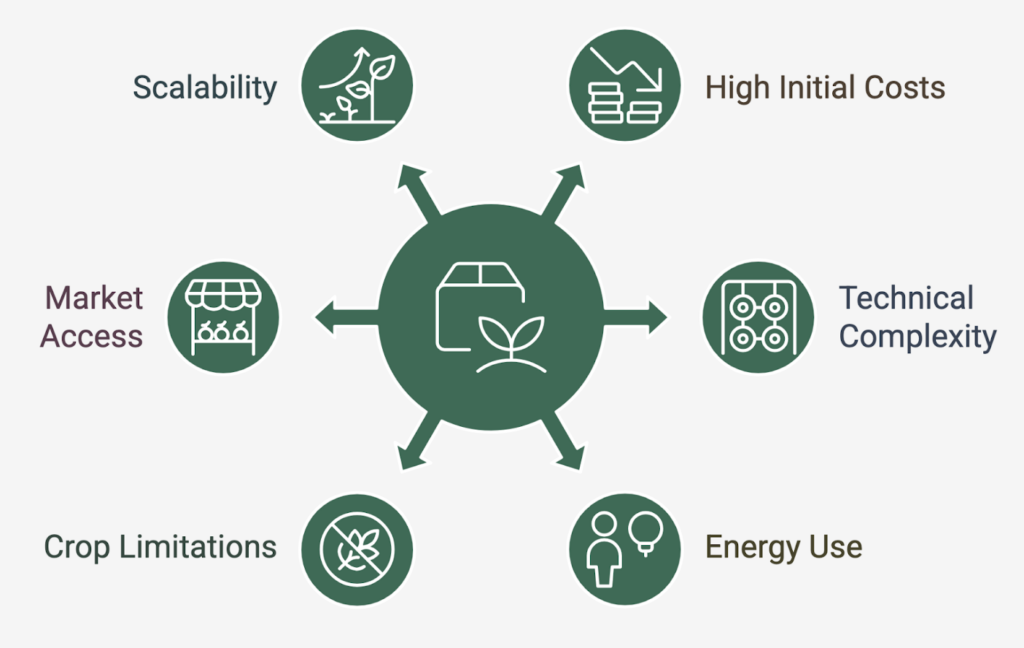
1. High Initial Costs
Setting up a CEA greenhouse or indoor farm requires substantial investment in infrastructure, automation systems, climate control, and energy-efficient lighting. For many growers, the capital required is a major entry barrier. While long-term operational savings may offset these costs, the upfront expense often limits adoption to well-funded or commercial-scale operations.
2. Technical Complexity
CEA farming blends biology, engineering, and data science. Managing nutrient delivery, lighting cycles, air circulation, and pest control in a closed-loop system requires specialized expertise. Without experienced personnel or adequate training, farms risk inefficiency or crop failure. This makes human capital just as important as financial capital.
3. Energy Use
Maintaining a stable greenhouse environment often demands constant use of HVAC systems, pumps, LED grow lights, and dehumidifiers. Energy bills can represent one of the largest ongoing expenses in a CEA operation. This has led to a growing need for renewable energy integrations and smarter energy optimization tools.
4. Crop Limitations
Not all crops are suited for CEA farming. While leafy greens, herbs, and tomatoes thrive in controlled environments, large-field crops like wheat, rice, and corn are still far too resource-intensive to grow indoors. Until advances in genetics or system design make them feasible, CEA will focus mostly on high-margin produce.
5. Market Access
CEA growers often focus on premium crops, but reaching the right customers can be difficult. Selling niche or high-value produce may require different marketing approaches, certifications, and retail partnerships. Consumer education is also key, especially when introducing less familiar products or explaining the benefits of CEA-grown food.
6. Scalability
While CEA technology is designed to scale, managing larger systems becomes increasingly complex. Each added zone or production layer increases the need for precise monitoring and control. Without strong digital systems and automation, scaling can lead to inconsistencies in crop health, yield, and quality.
Despite these challenges, continued innovation and support from agritech companies are helping to reduce barriers and increase adoption.
How Technology Can Help Overcome These Challenges
Advanced software platforms and digital tools are essential in making controlled environment agriculture more accessible, scalable, and profitable. Modern solutions help growers manage every aspect of their operation with precision and confidence. Labor and resource optimization tools balance daily tasks with available workforce, ensuring efficiency without burnout. Smart quality control systems monitor plant health and automatically flag issues based on image recognition or sensor feedback.
With real-time tracking and inventory management, growers can monitor stock levels, schedule harvests, and avoid overproduction. Integrated production analytics provide insights into yield trends, plant performance, and energy usage. Advanced routing and logistics optimization features reduce transit times and minimize spoilage, especially for perishable items. By consolidating data from various systems, growers can make faster, smarter decisions.
A platform like Folio3 AgTech brings these capabilities together into one integrated solution. The greenhouse management software is specifically tailored for CEA agriculture operations and has helped producers improve traceability, reduce waste, and enhance overall productivity.
Key features of the greenhouse software by Folio3 Agtech include:
- QR/Barcode for Batch Management
- Space & Facility Layout Planning
- Pest & Scouting Workflows (IPM)
- Lab Testing Integration
- Fertigation Scheduling & Monitoring
- Harvest Forecasting & Yield Analysis
- Sensor & Climate Data Integration
- Task Scheduling
- Mobile & Offline Functionality
Digital tools as such are no longer optional. In today’s complex agriculture landscape, they are vital to achieving consistent success.
Conclusion
Controlled environment agriculture represents the future of farming. As the world faces rising food demand, land shortages, and climate uncertainty, CEA farming offers a sustainable, scalable solution that redefines how and where we grow food. From high-tech greenhouses to urban container farms, controlled environment agriculture is pushing the boundaries of what’s possible in modern farming. With its ability to deliver year-round harvests, conserve resources, and enhance food security, the case for CEA agriculture is stronger than ever.
Still, it’s not without challenges. High setup costs, technical requirements, and energy demands must be addressed to ensure widespread adoption. That’s where technology comes in. By integrating real-time monitoring, automation, and advanced analytics, the greenhouse solution by Folio3 Agtech is empowering farmers to manage CEA greenhouse operations with greater precision and less risk as it offers tools that support everything from environmental control to inventory management and logistics.
Controlled environment agriculture is more than a farming method. It’s a systems-based approach to growing that combines science, sustainability, and smart software. And as this field continues to evolve, it holds the potential to transform global agriculture from the ground up.
FAQS
What Is The Controlled Environment Agriculture Program?
The Controlled Environment Agriculture (CEA) program is a specialized initiative or academic track that focuses on the science, technology, and systems behind growing crops in highly controlled indoor environments. These programs often cover greenhouse design, plant physiology, hydroponics, lighting systems, and automation, preparing students or professionals for roles in high-tech agriculture and sustainable food production.
What Is The Definition Of A Controlled Environment?
A controlled environment refers to any enclosed space where temperature, humidity, light, CO₂ levels, and other environmental factors are carefully regulated to optimize outcomes. In agriculture, this typically means settings like greenhouses or vertical farms where conditions are managed to support plant health, boost yields, and reduce exposure to external variables like pests or climate change.
What Is A Controlled Environment For Plants?
A controlled environment for plants is an enclosed system such as a CEA greenhouse or indoor farm, designed to maintain ideal growing conditions throughout the crop cycle. It enables farmers to precisely manage inputs like light, water, nutrients, and air circulation, helping ensure consistent quality, faster growth, and reduced resource waste regardless of outdoor conditions.
What Is The Difference Between A Controlled And Uncontrolled Environment?
In a controlled environment, variables like light, temperature, humidity, and CO₂ are actively monitored and adjusted to meet specific crop needs. In contrast, an uncontrolled environment (such as traditional open-field farming) relies on natural conditions and is subject to fluctuations in weather, pests, and other external factors. Controlled environments provide greater consistency, predictability, and efficiency in crop production.

